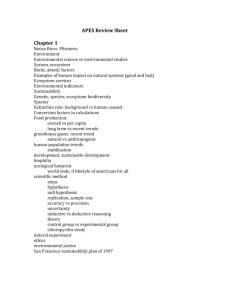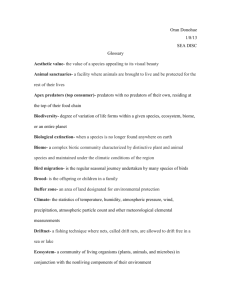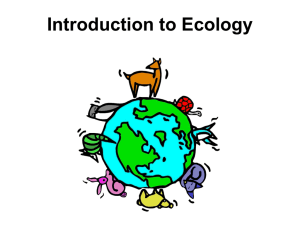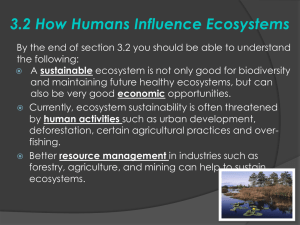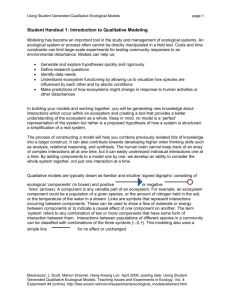Ecological Performance standards
advertisement
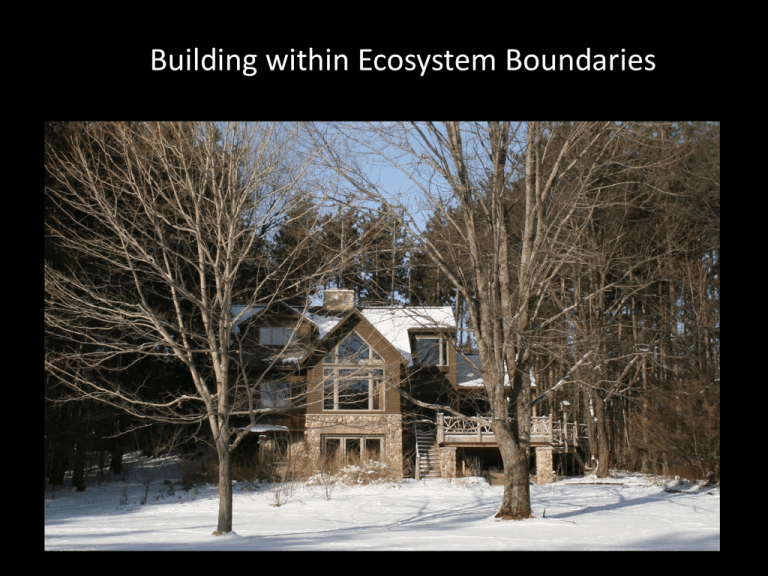
Building within Ecosystem Boundaries Ecological Performance Standards • To guide and Inform for building within ecosystem boundaries • A road map for site specific, ecologically sound building • Not a rating system • Based on performance • Build environment as part of a functioning ecosystem • Site specific guidelines • Reproducible process Holistic design rather then efficiency alone Sequestering carbon • Tree plantings, 50-60 trees a year Purifying water • 1200 gal. Cistern: flushes toilets, exterior spigots Reprocessing waste on site • Salvaged material Habitat creation Goals • Stay within the biological and abiotic boundaries • Manage for regeneration, succession, and resilience • Preserve and enhance the patterns of a functioning ecosystem Pickerelweed, Pontederia cordata Case study: 319 Marcellus Step 1: Site Assessment • Historical maps • Geographical information system (GIS) mapping: climate, soil, land cover, hydrology • Traditional and local ecological knowledge Historical Ecosystem Salt sheds, Creek channelization 1800’s -1900’s Digitized 1790 Vegetation survey Dr. Myrna Hall Current Street Grid ecological monitoring to guide design Step 2: Surveys and ecological monitoring • • • • • • • • • Energy Micro-climate Atmosphere Wildlife communities Water quality, Bio-Productivity Soil Community connectivity/food web Human Health Energy Resources E.P.S: Energy use • 4.03 kwh/m² /day in available solar resources • E.P.S: 2,770.3 kwh/day energy in total • Average U.S household: 8,900 kwh/yr • Only 24 kwh/day Solar thermal and PVC Passive solar design High efficiency and natural lighting Deciduous shade trees Carbon cycle • E.P.S: 1,653 lbs of CO² /yr stored on site • Avg US citizen produces 24 tonnes/person yr. Alternatives Vegetation Plant surveys and seed bank studies to guide management Vincetoxicum nigrum E.P.S: Creation of wildlife habitat using native species and natural structures for breeding, nesting, and foraging. Eastern Hemlock (Tsuga canadensis)……………Tannins for leather industry, Timber, Red Maple (Acer rubrum)……………………….. Syrup, Tonewood for instruments Yellow Birch (Betula alleghaniensis) . ……….Lumber for furniture, cabinets, Firewood Black Ash (Fraxinus nigra) ………………………. Basket-making, Firewood Tamarack (Larix laricina)……………Straight timber for ship masts, posts, railroad ties Eastern White Pine (Pinus strobus)………………. Medicinal tea, Timber Water Cycle • E.P.S: 257 gallons per day gallons water absorbed and purified • 40” rainfall and 115” snow received per year. rain gardens bio-swales rain water re-use gray-water purification and re-use, tree plantings, green-roof, rainwater-fed toilet >100 Sp. Fish Reduced to 12 sp. in 1950 Fishing banned in 1970. White fish, salmon, eel, regionally extirpated Water quality improvements through design Rainwater capture, pervious surfaces, no pesticides no chemical fertilizers infiltration techniques permanent erosion control Micro-climate • E.P.S: Emissivity of site averaging between .96-.97. • E.P.S: Albedo falls within the range of .17-.20 . Appropriate roof coloration and material, reduce or eliminate impervious surfaces, tree plantings Bio-productivity E.P.S: • Soil testing • Soil building practices – food scrap composting, – layer composting • On-site food production Step 3 Address Limitations • Changes in hydrology • Urban soils • Depleted seed bank • Zoning • Invasive species, mychorizal changes Solutions • Bridge species • Adapting standards for modern conditions • Succession and dynamic equilibrium of site • Staying within the ecological boundaries of reference ecosystem…….is not a restoration project Step 4: Design Goals • Perform within the environmental boundaries of a given reference ecosystem • Natural and biological processes to achieve performance goals whenever possible Passive Solar Design within planetary boundaries to protect life for the next seven generations

